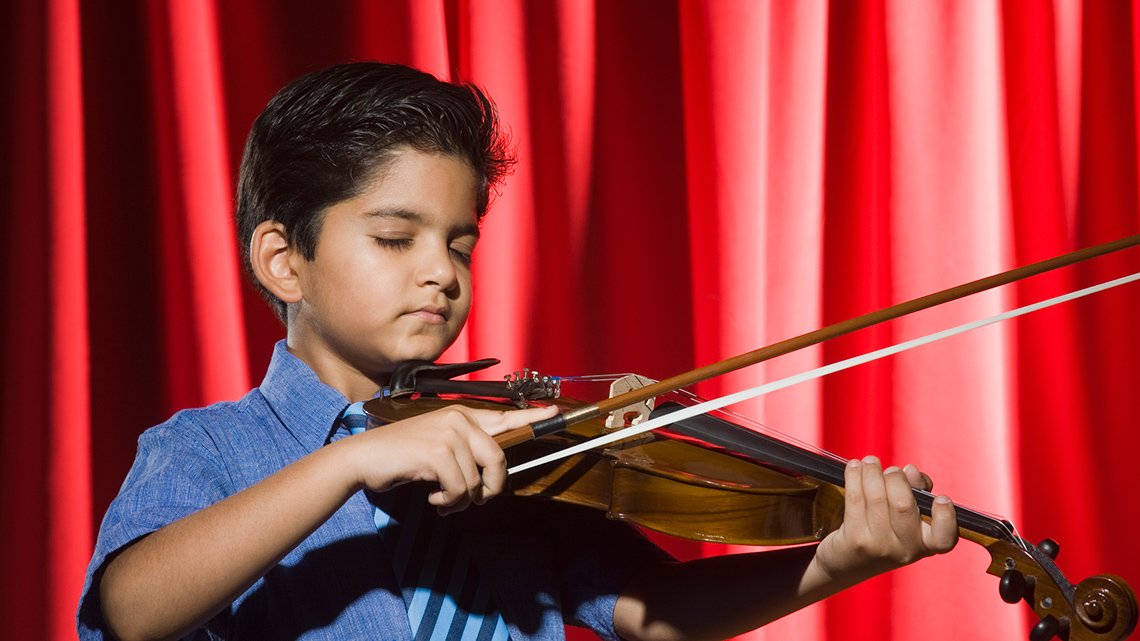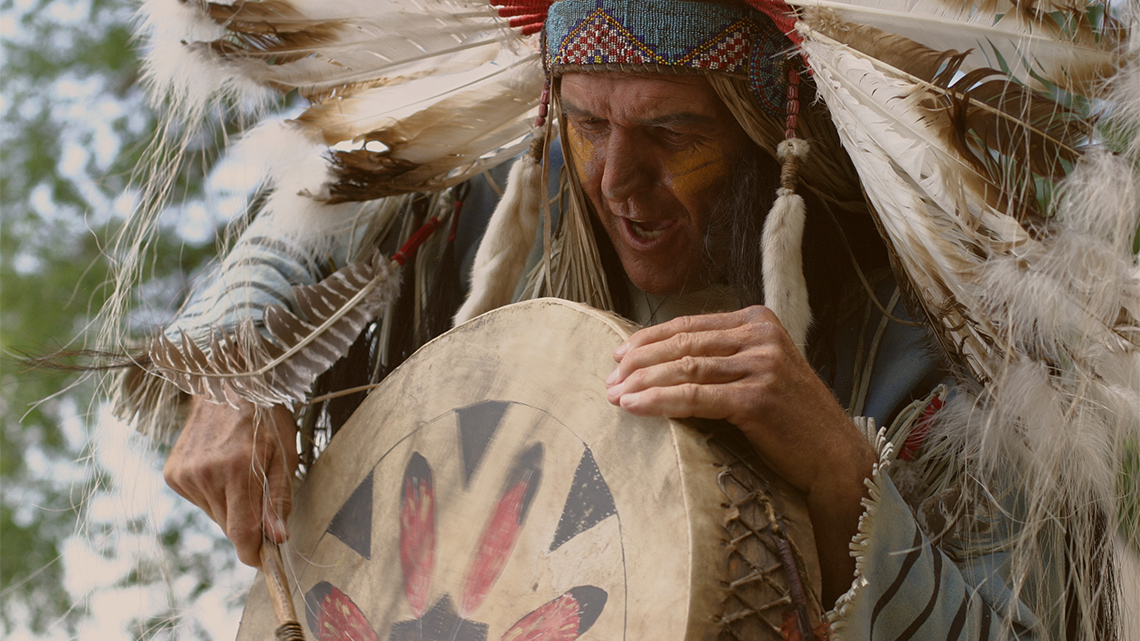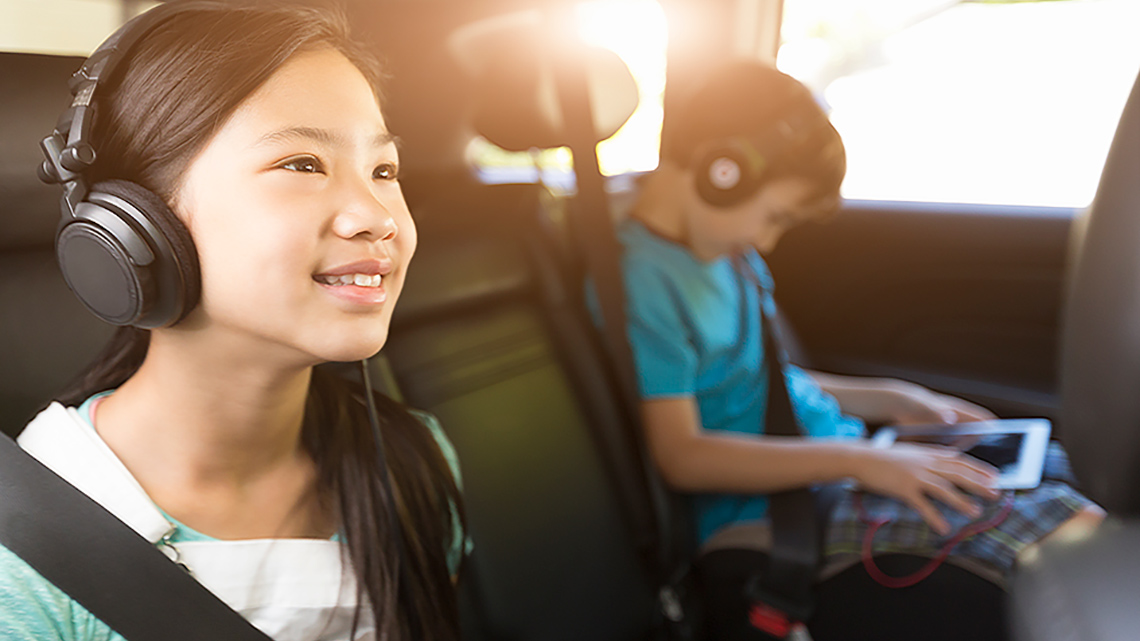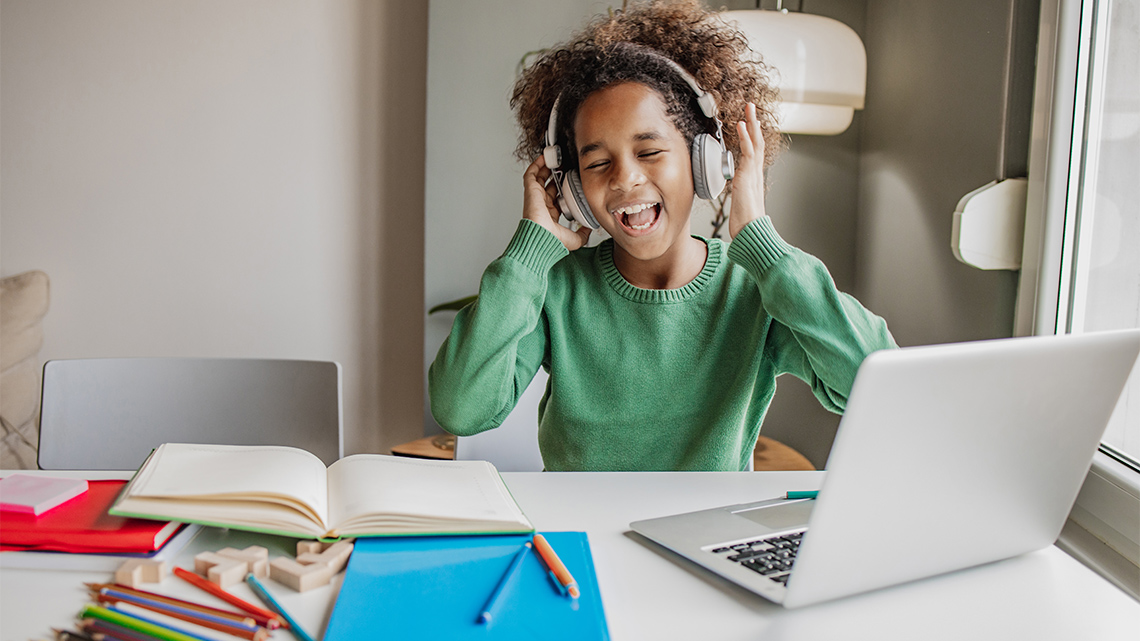Minds On
Today’s vocabulary
Press the following tabs to access today’s vocabulary.
The water drum is used for ceremonial and social dances, the beat of the drum represents the beat of the heart.
The water drum is made with a wood base that has a small hole and plug that can be removed to add water to it. The top of the drum is covered by an animal’s hide. It uses a band around it to hold it tight and in place. A small bit of water is added to the drum. When it is tipped, it moistens the animal hide. This helps it maintain its tone and pitch when it is struck with a stick.
The horn rattle accompanies water drums in both ceremonial and social music.
The horn rattle was traditionally made from buffalo horns. Today it is made with cow horns. The horn is cut into sections, placed together, and then capped with wood at each end. The handle is made of wood is inserted up through the bottom. The rattle can be filled with pebbles, corn, or pellets. Horn rattles sometimes accompany water drums in both ceremonial and social settings.
The turtle rattle is used specifically for ceremony or for healing. The turtle is a very important symbol for many First Nations communities.
The turtle rattle is made from the entire shell of the snapping turtle. The handle is made by stretching the head and drying it. The inside is filled with dried corn kernels. These kernels create the sound for the turtle rattle.
Let’s get started!

Two teachers talking. The first teacher says:
Music has been a part of many cultures around the world for centuries.
The second teacher responds:
Music can play different roles for people and their communities.
How do you experience music in your life?
As you create your list, explore the following images and descriptions of some roles of music in society.
Record your ideas digitally, orally, or in print.
Music plays a very important role in bringing people together.
Explore the following clip from the show Raven’s Quest that follows Drakon, a 10-year-old from the Tsimshian Nation who gathers with his community to sing and dance in Terrace, British Columbia.
Drakon is from the Tsimshian Nation in Terrace, British Columbia. The Tsimshian people are an example of a community that has passed their community’s teachings of music from one generation to the next.
In a Tsimshian ceremony, you feast, dance, sing, drum, and socialize. The girls sing and the boys dance and the girls are called in one by one in their crest groups. To dance they make the movements of the animals of their clan. These songs and dances are important because they show respect to a culture.
What role does music play for Drakon and his community?
Action
Get ready, get set…
Music can play different roles for people and communities. Some of these roles include:

This image is a mind map that explains the role of music in society. In the middle of the image is a big box containing the words “The role of music in society”. All around the big middle box, are 7 smaller boxes all containing words. Clockwise from on the top of the middle box–the words in the surrounding boxes are as follows: box 1 says “To teach and inspire”. Box 2 says “To soothe or to calm”. Box 3 says “Share culture and traditions. Box 4 says “To entertain or for fun”. Box 5 says “To heal”. Box 6 says “To celebrate”. Box 7 says “For enjoyment”.
In some communities, music can be passed down through generations.
In this learning activity, we will explore the role of music in the lives of two different Nations, both in the past and in the present.
In First Nations, Métis, and Inuit cultures, dance and music have deep meaning and are rooted in the traditions and teachings of their community’s ancestors.

Two teacher characters having a conversation. In the speech bubble above the first teachers head there is text that says:
We can learn a great deal about the Indigenous peoples through listening and learning directly from members of the community and through resources that the community has created to teach others about their rich identities and cultures.
Let’s revisit the video from the Minds On with Drakon.
The Tsimshian People
The Tsimshian people, meaning People of the Skeena River, are a First Nations community who live on the mainland and island on the coast of British Columbia and the Yukon. They also have communities in Alaska.
In the video, Drakon shared his teachings surrounding the potlatch. Potlatches are practiced specifically by Indigenous communities in the Pacific Northwest region of Canada and the United States.
Press ‘Learn more’ to access the definition of the word potlatch.
The word ‘potlatch’ means to give. It is a ceremony that is important to both the Kwakwaka’wakw Nation and the Tsimshian people, both in the past and in current society and culture.
In other North Pacific Coast First Nations communities in British Columbia, they may have slightly different teachings or ways of performing a potlatch ceremony. The Kwakwaka’wakw Nation is one of those communities.
The Kwakwaka’wakw
The Kwakwaka’wakw Nation is made up of eighteen First Nations communities that reach from northern Vancouver Island southeast to the middle of the island and include smaller islands and inlets of Smith Sound, Queen Charlotte Strait, and Johnstone Strait. Their territory is beside the Tsimshian.
The role of music at a potlatch
In a ceremonial potlatch, songs would be given to guests. The most treasured gift that someone can receive at a potlatch is a song. Songs are usually passed down within families to the oldest son. Nothing can equal the value of a song and to receive a song in the community, is like receiving a gift of very high status.
Dance shows what is being honoured at a potlatch. The dances are accompanied by songs as you explored in Drakon’s video.
In the past, Spirit helpers created songs that were used to share family traditions. There were songs for all occasions such as playing games, expressing love and sorrow, and soothing babies.
In the past during potlatch ceremonies, pieces of music used singers as well as drums, whistles, and horns to imitate the voices and calls of supernatural beings. Creation stories were shared through music and dance. These creation stories continue to be shared in potlatches today.
First Nations communities such as the Tsimshian people and the Kwakwaka’wakw Nation continue to have potlatch ceremonies.
Use your learning of the potlatch to answer the following true or false questions about the role of music in this ceremony:
Select the correct answer, then press ‘Check Answer’ to see how you did.
When music is played
Press the following types of instruments to learn more about what it does!
In many First Nations communities on the Northwest Coast, drums are made by stretching an animal hide over a wooden frame until it is tight and then lacing the underside. This holds the skin in place and gives a place for the player to hold the drum. Most drums are made of cedarwood.
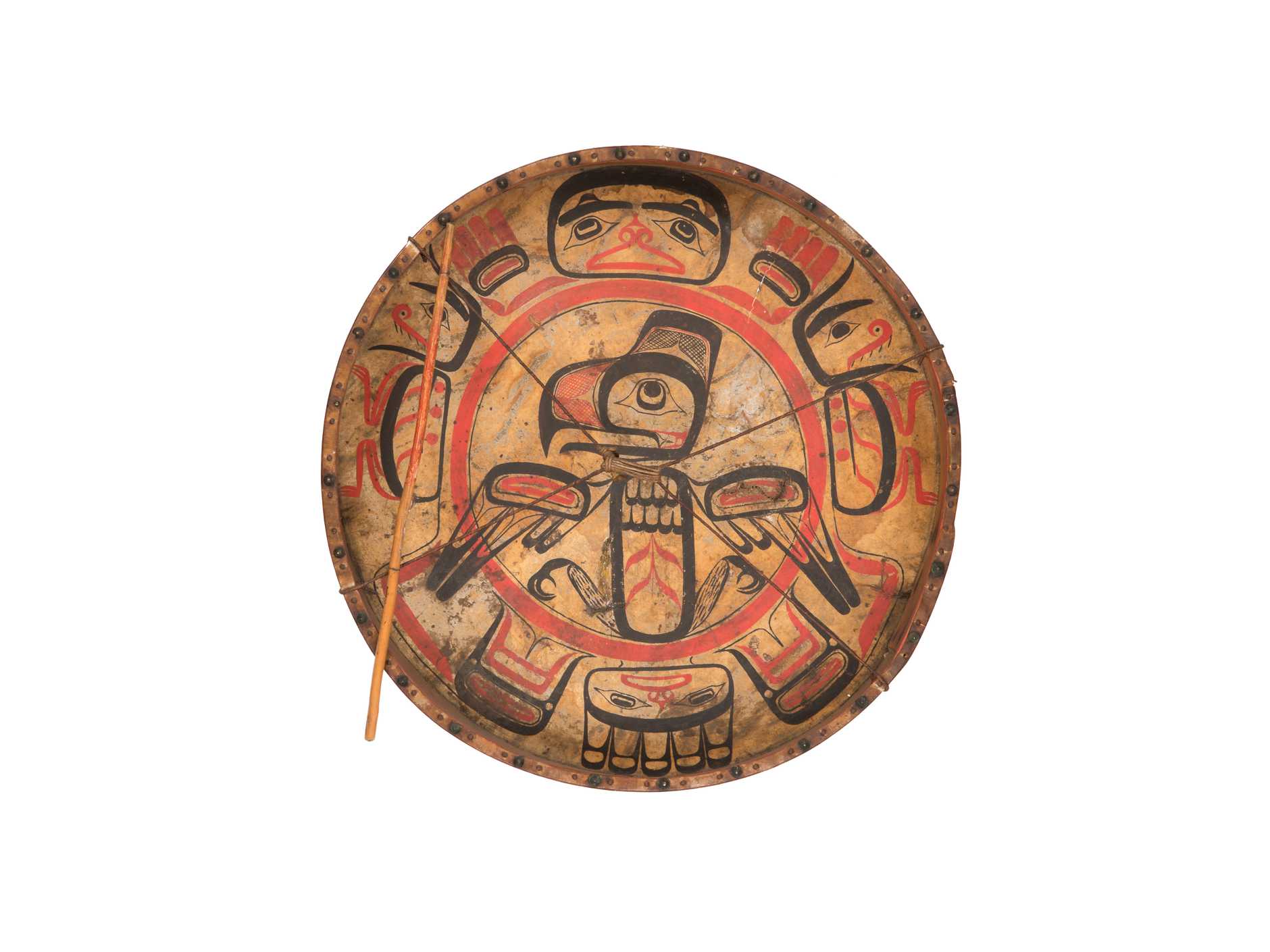
This drum is from Tsimshian territory in northern British Columbia. In the centre is an eagle. The eagle is circled by figures. The eagle’s tail forms one of the human’s heads.
The drum is seen as a tool for lifelong connection and relationship with all living things and the Creator. The circle shape of the drum represents equality and connection with the Creator at the centre around which all living things sit. Songs, dances, and oral histories are performed to the beat of the drum. Drumming together strengthens the connection among community members. Drums are treated with the utmost respect.
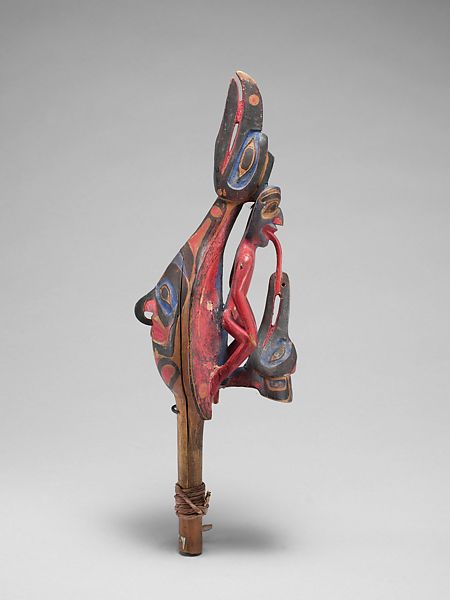
Rattles are used in dance rituals. The raven on a rattle is important as it was used by the chief when they were transferring some of their power to younger people. When the rattle was shaking and the music was played, the chief was gifting knowledge through the rattle and the rhythm.
This rattle represents a raven, a type of bird. On the back of the rattle are a shaman and kingfisher.
The Oneida Nation
Let’s learn about the Oneida Nation, the role of music in Oneida communities, and how music and the teachings and traditions carried through music have been passed through generations.
For many years, Canadians didn’t learn very much about First Nations, Inuit or Métis peoples in school. Now with the Internet, there are many resources in and outside of school to learn about Indigenous peoples in Canada.
When we want to learn more about how a Nation or group of people traditionally appreciated and experienced music, we can learn not just from historical sources but also from observing and learning how the community uses music today.
The Oneida name means the “People of the Standing Stone”.
The Oneida people have three different clans: wolf, turtle, and bear. These clans help inform the roles and responsibilities of each member of the community.
They are a matrilineal society, meaning their clan is passed down through mothers to their children.
Their traditional territory is in southern and southwestern Ontario as well as New York State and Wisconsin.
As we work towards Truth and Reconciliation, information about lands and territories is constantly being updated. This map was created using information available as of March 2022 from Learning Longhouse.

The role of music in the Oneida Nation of the Thames
The Oneida Nation of the Thames is in Southwestern Ontario, near London. In this community, ancestors traditionally passed down their culture, history, and ceremonies, through oral communication and traditions. This includes music!
Teachers of music in the Oneida community say that learning happens through music and that singing is a healthy way to release emotions within one’s heart.
Music plays a role in healing. This can help individuals get through tough times or to express their happiness.
The Oneida have been taught that communities coming together in song is central to its identity and being. It is not a few who sing, everyone sings. It brings the people power. It unites them and connects them to their past. Living traditions can be kept alive through singing.
Singing brings the community together, and thanks can be given to their Creator.
The language of music is used for both ceremonial and social reasons.
Press the following tabs to access different categories of music.
Ceremonial music is for forms of healing and giving thanks. The songs were gifted to the Oneida for ceremonial purposes or medicine rituals. The songs have been passed down for generations and are still used today.
Social music is used for gatherings big and small that bring people together for dancing and socializing as well as to have fun and meet new people. Social music is used at Powwows and sung and played for fun and entertainment.
Waskwaabiish, a 10-year-old boy will share his regalia and perform his smoke dance to traditional music that is a part of the Powwow ceremony.
Check out this video from the TVO show Raven’s Quest entitled “Waskwaabiish” to learn more about the Powwow ceremony.
What does Waskwaabiish share about the importance of this dance to him?
Press ‘Importance of Dance’ to access a possible response.
Waskwaabiish enjoys dancing to traditional music with his family and friends and is very proud of his tradition and skills.
The role of music at a Powwow
Although potlatch ceremonies are only practiced by some First Nations communities, Powwows are practiced by many First Nations communities.
A Powwow is a celebration that many First Nations communities take part in. A Powwow is a large celebration with music, dances, regalia, food, and crafts.
Powwows include ceremonial and social music, and the focus of a Powwow is celebrating and being together. A Powwow is Indigenous peoples’ way for meeting together, to join in dancing, singing, visiting, renewing old friendships, and making new ones. Powwows occurred in First Nations communities in the past and continue to be a part of First Nations communities today.
The main music at Powwows is usually performed by 12 men who sit in a circle around a large bass drum often called the big drum. The men strike the drum at the same time and are led by a single singer who is then joined by the others. The women use the hand drum to perform in many communities or they will support the men drumming by singing or standing behind them at the big drum.
Did You Know?
Did you know?
In 1876, the Canadian government passed the Indian Act to control the lives of Indigenous people. The government used the Indian Act to ban cultural ceremonies, such as the Potlatch and Powwows, until 1951. Members of many Indigenous communities were afraid that their traditions and ceremonies would be lost because of these policies. However, Indigenous people resisted. Some First Nations communities held Potlatch ceremonies and Powwows in secret. In the 1960s, many First Nations communities began to host Powwows openly.
Indigenous people continue to pass on knowledge, traditions, and cultural ceremonies over generations. Today, many public Powwows are celebrations of Indigenous culture, where everyone is welcome.
Use your learning to answer these questions about the Oneida Nation and the importance of music to their culture and traditions.
Select the correct answer, then press ‘Check Answer’ to see how you did.
When music is played
Press the following tabs to access the instruments played within the communities.
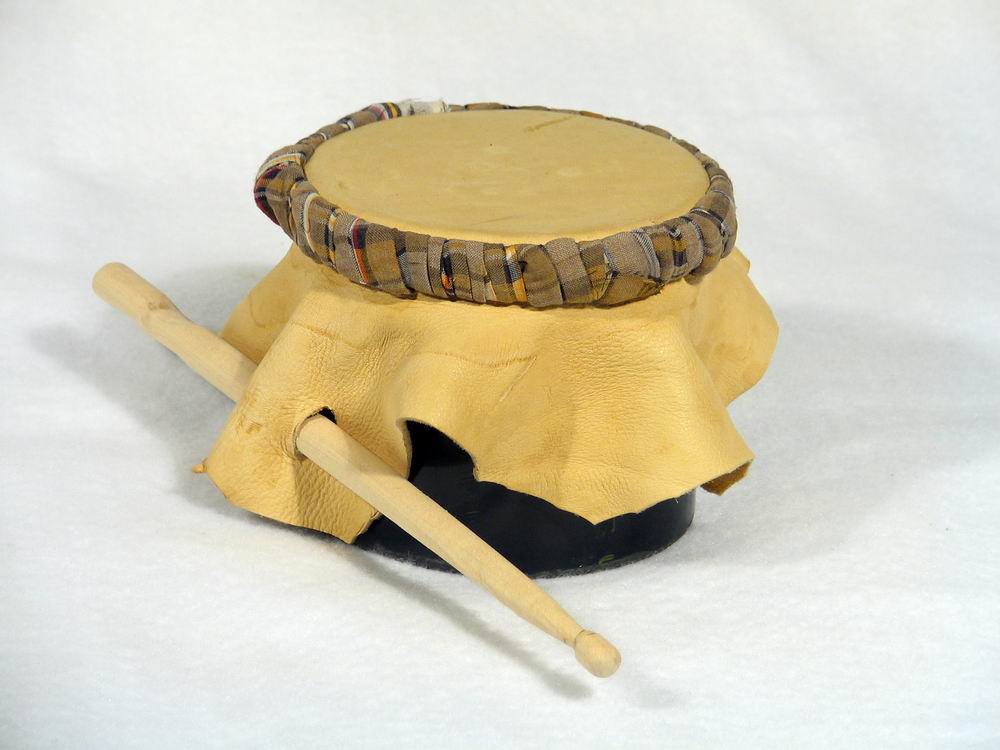
The water drum is used for ceremonial and social dances, the beat of the drum represents the beat of the heart.
The water drum is made with a wood base that has a small hole and plug that can be removed to add water to it. The top of the drum is covered by an animal’s hide. It uses a band around it to hold it tight and in place. A small bit of water is added to the drum. When it is tipped, it moistens the animal hide. This helps it maintain its tone and pitch when it is struck with a stick.
Check out this audio recording to learn more about the sound of the water drum!
The Water Drum
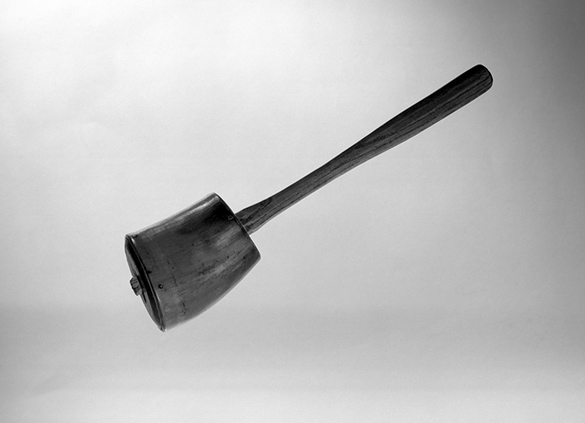
The horn rattle accompanies water drums in both ceremonial and social music.
The horn rattle was traditionally made from buffalo horns. Today it is made with cow horns. The horn is cut into sections, placed together, and then capped with wood at each end. The handle is made of wood is inserted up through the bottom. The rattle can be filled with pebbles, corn, or pellets. Horn rattles sometimes accompany water drums in both ceremonial and social settings.
Check out this audio recording to explore the sound of a horn rattle!
The Horn Rattle

The turtle rattle is used specifically for ceremony or for healing. The turtle is a very important symbol for many First Nations communities.
The turtle rattle is made from the entire shell of the snapping turtle. The handle is made by stretching the head and drying it. The inside is filled with dried corn kernels. These kernels create the sound for the turtle rattle.
Check out this audio recording to explore the sound of a turtle rattle.
The Turtle Rattle
Connections
Connections
Discuss the role music plays in the Oneida, Tsimshian, and Kwakwaka’wakw communities. These roles are important to the communities in the past but are also just as important today.
- Is the music ceremonial or social?
- What musical instruments are used?
- How is music included in the potlatch? How is it included at a Powwow?
Record your ideas in a method of your choice.
Press ‘Let’s Check’ to reveal possible answers.
|
Role of Music |
|
|---|---|
|
Oneida community |
Tsimshian community |
|
Possible answers: Music is used to gather people. Music is used to celebrate at Powwows Singing connects people to those in their past and brings healing and thanks The drum represents the heartbeat The turtle rattle is used for healing as the creator rested the whole world on the turtles back. |
Possible answers: Music is gifted to others at potlatch Music honours others Songs are gifted to one another The drum is seen as a tool for lifelong connection and relationship with all living things and the Creator Rattles passed knowledge and teaching from Chief to the young. |
Consolidation
Putting it all together

Use the following questions to reflect on your learning.
Choose either the Oneida Nation, the Kwakwaka’wakw Nation, or the Tsimshian people when you reflect on your learning.
- What is the importance of passing down music from generation to generation in this community?
- Is there a difference between the role of music in the past and the present in this First Nation community?
- The role of music is very important in the lives of this First Nation community. In what ways does music play a role in your life?
Record your ideas in a method of your choice.
Reflection
As you read through these descriptions, which sentence best describes how you are feeling about your understanding of this learning activity? Press the button that is beside this sentence.
I feel...
Now, record your ideas using a voice recorder, speech-to-text, or writing tool.
